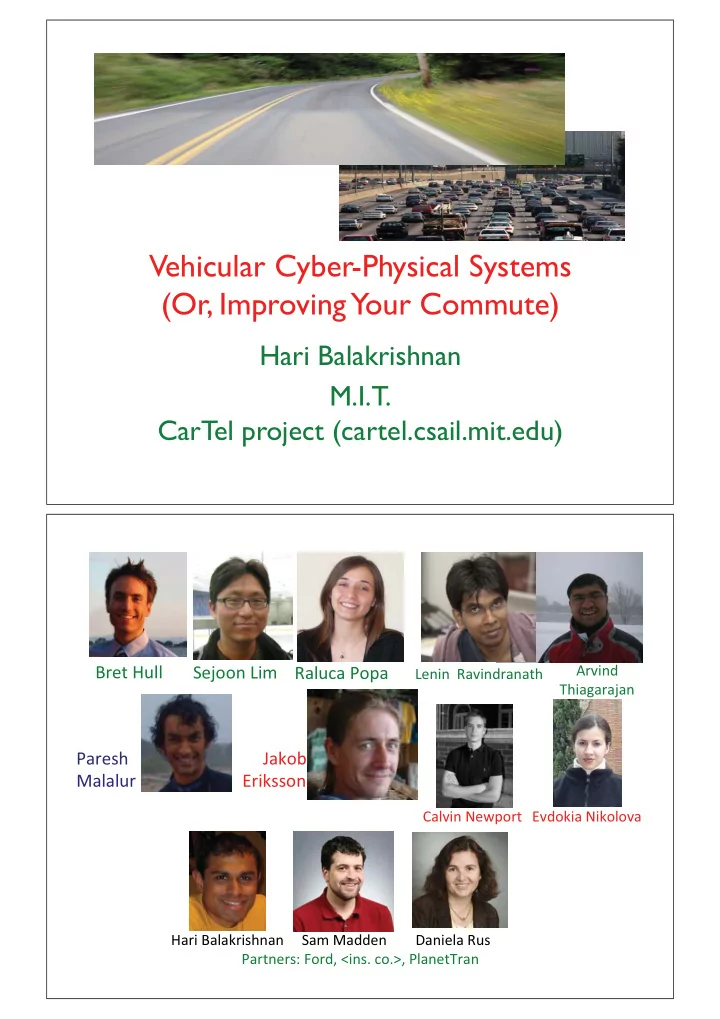

Vehicular Cyber-Physical Systems� (Or, Improving Your Commute) � Hari Balakrishnan � M.I.T.� CarTel project (cartel.csail.mit.edu) � ���������� �������� ����������� ������������ �������������������� ������������ �������� ������ �������� ��������� ��������������� ����������������� ������������������ ����������� ������������ ���������������������������������������
The Challenge � • Road transportation presents an array of hard problems worldwide� • Accidents & hazards, congestion (routing & tolling), emissions & pollution, degrading infrastructure, telematics� Traffic Problems � Rush � Hour � 1982 2005 1982 2005 12 12 Morning 3 3 Commute 12 12 Evening 3 3 Commute 80% of world’s population is in places where automobile growth is occurring at >20% per year US BTS B Highway congestion costs $128 billion annually� ghway congestion costs $128 billion annually h ti t $128 billi ll Avg commuter travels 100 minutes a day� 33% commuters stuck in very heavy traffic at least once/week� ������� ������������������������������������������������
Phones as Probes � • Gather <time, position, otherdata> Camera� samples from phone� • Map sequence of positions to a Accelerometer� trajectory � Compass� • Estimate delays & other data for Gyro� GPS� individual road segments� • Use in prediction, combining WiFi� Cellular radio� historic and current information� Microphone� Phones as Probes: Challenges � Accuracy� Errors & outages� Battery Drain Curve 100 Remaining Battery Life (percentage) GPS every 1s Energy� GPS every 120s 80 GPS is an energy hog: 400 Android G1 60 mW for continuous monitoring� 40 Effective radiative power � 20 only 2*10 -11 W/m 2 � 0 (Cf. cellular radio: 10 mW/m 2 0 200 400 600 800 1000 1200 1400 1600 1800 – 117 dB difference!) � Time Elapsed (minutes) Location privacy� � A. Thiagarajan, L. Sivalingam, K. LaCurts, S. Toledo, J. Eriksson, S. Madden, HB, Sensys, 2009
Idea: Trade-off Accuracy for Longer Battery Life � GPS has outages and errors� ���� in urban canyons� Cellular all the time, WiFi some of the time, � ������� and GPS infrequently� ����������� ������ Augment with accel & compass for turn hints� ���� ������ ���� ����� ���������������������������� Input: Radio Fingerprint Sequence � Base station / Access point � | Signal strength� d8:30:62:5f:be:da | RSSI -94 00:0f:b5:3d:43:20 | RSSI -58 00:18:0a:30:00:a3 | RSSI -51 . . . . . . . . . . . . . .
Current RF Localization Produces Poor Trajectories � • State-of-the-art: localize each RF fingerprint to best static location [ PlaceLab]� � • Ok for point localization – poor for tracks� CTrack: Accurate Trajectory Mapping with Cellular Signals � • Maximum-likelihood trajectory estimate� • Operates directly with fingerprints using a 2-stage hidden Markov model (“soft decision decoding”)� • 75% as accurate as 1 Hz GPS� • Energy comparable to GPS every 240 seconds (on Android G1)� A. Thiagarajan, L. Sivalingam, HB, S. Madden, NSDI 2011
HMM fingerprints � Raw points (placelab)� to grid sequence� Smooth + interpolate� HMM smooth grid to map� grid sequence� Delays are Inherently Probabilistic � Speed (Delay/Length) � Time of day � P . Malalur, A. Thiagarajan, HB, S. Madden, � � Traffic Prediction from Historical Observations � , 2011�
Traffic-Aware Stochastic Routing � • You need to reach the airport by 6 pm. You leave at 4.45 pm. What route should you take?� – Want max probability route� – Or, for a given probability of arrival, minimize time for arrival with at least that probability� • Goal: Credible routes & accurate estimates� • Practical solution for single-user planning� • Challenges: fast online re-routing, multi-user routing, multi-mode routing� 13 Stochastic Routing Isn’t Easy � • Optimal substructure property doesn’t hold� � Mean 5 PDFs of path delays A � B St.dev. 3 B C A 4 Mean 7 St.dev. 1 deadline time �
Stochastic Routing Isn’t Easy � • Optimal substructure property doesn’t hold� Mean 5 PDFs of path delays A � C St.dev. 3 B C A 4 Mean 7 � St.dev. 1 deadline time • Non-convex objective� Key Insights � Insight 1 : min Prob(late) for Gaussian is Mean-Variance of Paths equivalent to:� var � �������� ���������� minimize path mean – t � p ������� {paths} √path var. √ th Insight 2 : Visualize on mean-variance plane � (path mean – t)² (p ) � path var. th t mean Insight 3 : Solution is on (deadline) bottom-left quadrant boundary� Evdokia Nikolova, � Strategic Algorithms � (stochastic � shortestpaths via quasi-convex maximization)�
Practice: Pruned Parametric Optimization� • Set edge weight = m e + � * v e� • Search over � by running deterministic shortest paths with above weights� • Prune search space efficiently : O( N 2 polylog N ) avg time� • ~2-10 shortest path computations (~1-3 seconds)� Variance Undiscovered path� Discovered path� 0 d Mean Lim, HB, Madden, Rus, Stochastic Motion Planning and Applications to Traffic , IJRR 2010� Example: 4 pm MIT to Alewife� ����������������������� s ���������������������������� ������� �������� ���������������� ����������� ���������� ���������������������������������������� ������������������������������������������������������
iCarTel iPhone App � Conclusion � • Transportation is a � grand challenge � problem� • Vehicular cyber-physical systems combining mobile sensing, wireless networking, and mobile/cloud computing can help� • Many interesting problems� – whose solutions have to be embedded in a complex social and physical context� • cartel.csail.mit.edu�
Recommend
More recommend